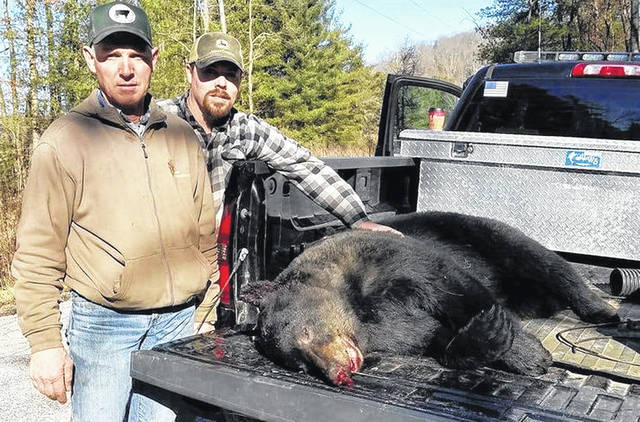
A large black bear was struck and killed by a vehicle on Christmas night on SR 32 in eastern Adams County, according to several area sources.
The bear weighed 261 pounds, WKRC reported.
“The bear should have been in hibernation but perhaps due to the unseasonably warm weather it was not. All of Adams County is saddened by the event,” said the Adams County, Ohio Travel and Visitors Bureau Facebook page. “A black bear had been observed and reported numerous times the past two years in that region of the county which is mostly remote mountains and forest bordering Pike and Scioto counties.”
The bear will be examined by the ODNR.
Suzie Prange, an Ohio Wildlife research biologist with the Ohio Department of Natural Resources Division of Wildlife, said in a story on the ONDR website that no one knows for sure how many black bears reside in Ohio, but that a good estimate would be 50 to 100.
She also said the number is slowly increasing.
”They are increasing slowly, and this is normal for black bear populations, especially recovering ones,” Prange said. “The age when females first produce cubs is related to the available food supply, but most begin to reproduce at age 3 or 4. Some don’t reproduce until eight years of age. Once a female reproduces she will usually continue to have young every two years, but again this is related to nutritional status and may be as long as every four years. Litter size is small and ranges from one to four cubs, with litters of two or three being most common. Cubs are weaned when they are about 7 months old and will remain with the female until the second summer of their lives. Then, the young bears, especially males, may travel great distances in search of their own territories. Yearling females frequently settle near their mother’s home range.
“Most bears sighted in Ohio are likely young, dispersing males. They will settle in a territory in Ohio, but only if they find an area with a female. Because females tend to settle next to their mother’s territory, black bear range expands very slowly. Many of the young males we see each year in Ohio won’t find females and won’t stay.”
Prange said most black bear sightings are most frequent in the eastern half of Ohio.
“Black bears are woodland species, they can occur in deciduous or coniferous forests. They prefer forested areas that are interspersed with openings. Forests, such as the hardwood forests in Ohio, provide acorns and hard mast in the fall, whereas openings are good sources of berries and young plant growth in the spring and summer.
“As such, they occur predominately in the eastern half of Ohio. Most sightings are in the northeastern part of the state. However, there are also more people to see them there. It is likely there are more bears in the more remote, unglaciated region of Ohio (southeastern Ohio) than we would think given the small number of reported sightings because there aren’t many people there to see them.”
According to Prange, habitat in southeastern Ohio is not quickly changing, and is actually been recovering from deforestation in the late 1800s and early 1900s. Its recovery is one of the factors making the recovery of black bears, as well as other species, possible. Areas in northeastern Ohio where the human population is growing and expanding are not likely good black bear habitat to begin with. Bears need large expanses of forested land with relatively low human density.
Males black bears are larger than females, Prange said, with males typically weigh from 150 to 400 pounds, although bears as large as 600 pounds have been reported (not in Ohio). Females weigh from around 100 to 200 pounds. Adults are usually up to 6 feet long, but may be up 7 feet long nose to tail. When on all fours, which is the typical stance, bears stand about two to three feet at the shoulder.
Black bears are extremely agile and are able to run up to 35 mph, climb trees with ease and swim long distances. Bears are omnivores, meaning they will eat a wide variety of foods. Depending on the season, their diet may include grasses; forbs; berries; mast from oak, hickory and beech trees; carrion, and insect larvae. Bears will also consume agricultural crops, if available, according to the ODNR.
To report observations of black bears, submit a report online via the Wildlife Species Sighting Report, or contact your local county wildlife officer or regional District Wildlife Office.


